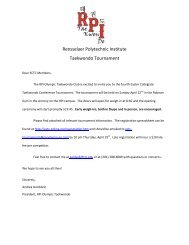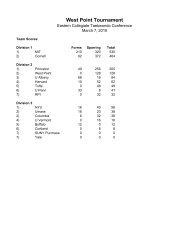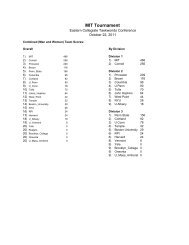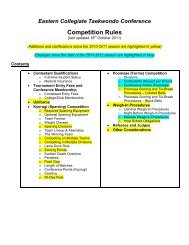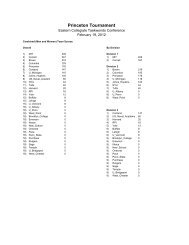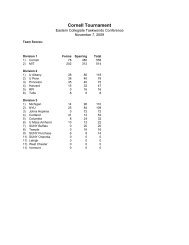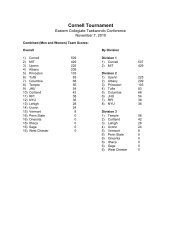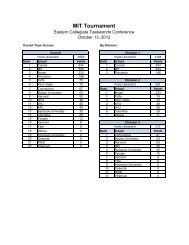ECTC Competition Rules
ECTC Competition Rules
ECTC Competition Rules
Create successful ePaper yourself
Turn your PDF publications into a flip-book with our unique Google optimized e-Paper software.
Weight Class Men WomenLight 0-145.0 lbs 0-117.0 lbs.Middle 145.1-172.0 lbs 117.1-137.0 lbsHeavy over 172.0 lbs over 137.0 lbsA competitor may spar "up" a maximum of one weight division, at his/her coach's discretion. Forexample, middleweight may spar in the heavyweight slot, but a lightweight may never spar in theheavyweight slot. Competitors may not spar in a lighter weight class than the one they weigh in as.Sparring divisions. There are 4 skill levels at <strong>ECTC</strong> competitions: A-Team (Advanced), B-Team(Intermediate),, C-Team (Beginner), and D-Team (First-Time) for both men and women. Thus, thereare a total of eight divisions:Sparring DivisionsDivision Size of Team RankWomen's A-Team 3 Women, 2 Alternates Black Belts and belowMen's A-Team 3 Men, 2 Alternates Black Belts and belowWomen's B-Team 3 Women, 2 Alternates Red Belts and belowMen's B-Team 3 Men, 2 Alternates Red Belts and belowWomen's C-Team 3 Women, 2 Alternates Green Belts and belowMen's C-Team 3 Men, 2 Alternates Green Belts and belowWomen's D-Team 3 Women, 2 AlternatesYellow Belts and below,first tournamentMen's D-Team 3 Men, 2 AlternatesYellow Belts and below,first tournamentB-team competitors may also spar in A-team competition at the same tournament. C-teamcompetitors may also spar in B-team divisions at the same tournament. However, no competitor mayspar in both the C and A-team divisions at the same tournament. Once a competitor has beenentered in the A-team division, he/she may not spar in the C-team division at any future <strong>ECTC</strong>tournaments. Also, any competitor entered in the D-team competition may not spar in any otherdivisions for that tournament.D-team division rules. The purpose of this division is to provide first-time sparring competitors with apositive experience against other competitors with limited Taekwondo sparring experience.All competitors in the D-team division must, in addition to being full-time students, must be:1) White or Yellow belt in rank (yellow belt with green stripe or orange belt acceptable)2) Must have never participated in a martial arts tournament sparring match before.During the first round, D-Team competitors may only use their right leg to spar. In the second round, -Team competitors may only use their left leg to spar. The reason for this rule is to reduce thefrequency of injuries in the competitors.
D teams will earn no points for their teams. Once a competitor has competed in the D-team division,he/she may not compete again in the D-team division at future tournaments.Match Length. Sparring matches are two rounds long, lengths varying according to the level ofcompetition as described below.DivisionA-Team KyorugiB-Team KyorugiC-Team KyorugiD-Team KyorugiDuration of Rounds for Sparring (Kyorugi)Time of Sparring2 rounds of 2 minutes with a 30 second rest2 rounds of 90 seconds with a 30 second rest2 rounds of 60 seconds with a 30 second rest2 rounds of 60 seconds with a 30 second restPoint awards for team sparring. For each division, all teams within that division will be entered intoa single elimination bracket. One 1st place, one 2nd place, and two 3rd places will be given alldivisions. No points are awarded for D-team sparring.Sparring Point Awards1st 2nd 3rd 3rd 5th 5th 5th 5thD-Team 0 0 0 0 0 0 0 0C-Team 64 32 16 16 8 8 8 8B-Team 96 48 24 24 12 12 12 12A-Team 128 64 32 32 16 16 16 16Also, one school may not earn points for more than 2 teams per division in a single men's or women'sdivision. For example, if MIT places 1st, 2nd and 3rd in men's B-team sparring, then they will onlyreceive points for the 1st and 2nd place teams, but not for the 3rd place team. This rule is intended tomake sure that large teams do not have too much of an advantage over smaller ones.Seeding. Seeds will be awarded based on the total number of team points scored by each team (i.e.MIT A1, Cornell A2, NYU C2) at the last 3 tournaments. i.e. if Tufts Men's C2 earned a bronze medalat the previous tournament, a silver medal at the tournament before, and no tournament at theseason before, then they would earn 40 points towards their seed in the current tournament).Number of teams. Each school may enter as many teams as desired per division. However, no morethan two teams from any one school may score points in a single division.Lining teams up. For a team vs. team match, competitor match-ups will be decided on the initialteam lineup of two teams before any sparring begins. Alternates must line up behind the person forwhom they may substitute for that match.- No competitor may spar two positions within the same team.
- Because a competitor may qualify for more than one weight division, it is possible for there to bemore than one legal lineup for a given team. Thus, a competitor cannot change his/her placementafter the initial lineups have been decided until after all 3 matches have been contested.- In the event that both teams have flexibility in their lineup and cannot agree, then they shall eachwrite their chosen team down on a sheet of paper to be submitted to the referee, who will then revealboth teams simultaneously.- After a team has advanced to the next round, they are not required to keep the same lineup thatthey used in the last match.Determining the winner of two teams. Because schools may not have enough competitors to fill acomplete team, different combinations of competitors are possible. The winner between two teamswill be decided as follows:Criteria for advancement for a 3 person vs. 3 person team. The winner is determined by the teamthat wins two or more matches.Criteria for advancement for a 3 person vs. 2 person team. The 2 person team must win bothmatches to advance, otherwise the 3 person team advances.Criteria for advancement for a 2 person vs. 2 person team in the same weight classes. Thewinner is determined by the team that wins two matches.If, after two matches, each team has won one match, then the winner is determined by the team thatscored the most number of points across both matches. I.e. if match 1 was won by Red, 7:3, andmatch 2 was won by Blue, 3:5, then the total score across both matches is 10:8 in favor of Red, andRed advances.If after both matches each team has won one match, and the cumulative score is also tied, then thewinner is decided by the referee on the basis of cumulative superiority across both matches. Thus,the center referee must be aware of this possibility and track the superiority of the players across bothmatches. Superiority is defined as the player who showed more initiative during the match.Criteria for advancement for a 2 person vs. 2 person team which share only one weight classin common. If, for example, Red has only a middleweight and a heavyweight on its team, and Bluehas only a light weight and a middleweight on their team, then the winner is determined by the winnerof a single middleweight vs. middleweight match.Criteria for advancement for a 2 person vs. 1 person team. A 2 person team always advancesover a 1 person team. However, the 2 person team must spar out the match in good faith against the1 person team or risk disqualification for the rest of the division.Criteria for advancement for a 1 person vs. 1 person team. The team to win the single matchadvances in the bracket.
"Lame duck" rule. All competitors must compete even if his/her team has already qualified toadvance to the next round, unless the competitor is severely injured and cannot compete. There willbe no voluntary forfeits. If the competitor withdraws either before or during a match due to injury, thenhe/she may not compete in any other matches in that sparring division (i.e. A, B, C) even if his/herteam advances. However, he/she may return later in the day to spar in a different division.The only exception to this rule is if an alternate is substituted in his/her place. In that event then theplayer who was substituted out may later spar in another match within the same division.This rule is designed to enrich the experience of all competitors whether they win or lose and to makesure that everyone has an opportunity to compete.Example. In the semifinals, MIT Men's A1 meets RPI Men's A1, with 3 players on either side. Neitherteam has any alternates. RPI A1 wins the light and middleweight matches. RPI A1's heavyweight maynot withdraw and save himself for the finals - he must spar the match to completion. If he does decideto withdraw due to injury, or if he does not complete the match, then he may not compete in the A-team finals. However, if the RPI A1 heavyweight is entered in the Men's B-team competition as well,he may compete in that division regardless of any withdrawl in the A-team division.Alternates. 2 alternates per team are allowed. Alternates are to be used as substitute players for ateam in the event that a player for that team is injured or wishes to withdraw from competition.Alternates may only substitute for a player of the same weight class.Alternates may be on the team list for a maximum of two teams within a division, but cannot actuallycompete for (i.e. spar or force a forfeit for) more than one team within a division. Once an alternatehas competed for one team, he/she may not compete for another team within the same sparringdivision (A, B, C).Weigh-ins. Weigh-in shall be conducted in uniform with a 2 pound allowance. Weigh-in shall bemade once; however, one more weigh-in is granted within the time limits for official weigh-in to thecontestants who did not qualify the first time. Weight divisions are enforced for all sparring divisions.Sparring on multiple teams within a division. A competitor cannot spar or compete for more thanone team within his/her division (i.e. Men's A-team) within a tournament. Thus, if a competitor is analternate on two teams, he/she is ineligible to compete for any other teams in that division oncehe/she has competed for (i.e. sparred or forced a forfeit for) a particular team.Example 1: John is an alternate for both MIT Men's A1 and MIT Men's A2. He is substituted in on MITMen's A2 to spar one match. He may not compete for MIT Men's A1 for the rest of the tournament,although he may continue to spar with MIT Men's A2.Example 2: Betty, a middleweight at 130 lbs, is an alternate for both Cornell Women's B2 and CornellWomen's B3. Cornell Women's B3 has only two players in addition to Betty - a light and a middleweight. They are matched up against NYU B1, which has only 2 competitors - a light and a middleweight, with no alternates. Betty is asked to line up with Cornell B3 as their heavyweight to force a
forfeit of the heavyweight match by NYU. Betty may not then later spar for or force a forfeit for CornellWomen's B2.Sparring in more than one division. A color belt competitor who is entered in a B-team division mayalso compete on an A-team. This rule is aimed at the individual who may not be the rank of a blackbelt, but can compete at the level of a black belt.Likewise, a competitor who is entered in the C-team division may also compete in the B-teamdivision. However, a competitor may not be entered in both the C-team division and the A-teamdivision.Once a competitor has sparred in the A-team division, he/she may not compete in a C-team divisionagain at the same or any future <strong>ECTC</strong> tournaments, regardless of his/her rank.Poomsae (Forms) <strong>Competition</strong>Divisions. There are ten poomsae divisions (including both Men and Women), defined as follows:Poomsae (Forms) Divisions – separate Men’s and Women’s DivisionWhite/Yellow - Taegeuk 1 or 2 (the competitor chooses which form to do)Green - Taegeuk 3 or 4 (the competitor chooses which form to do)Blue - Taegeuk 5 or 6 (the competitor chooses which form to do)Red/Brown - Taegeuk 7 or 8 (the competitor chooses which form to do)Black:1 st tournament: Taegeuk 8. Top eight advance to Final Round: Koryo2 nd tournament: Koryo. Top eight advance to Final Round: Keumgang3 rd tournament: Keumgang. Top eight advance to Final Round: Taebaek4 th tournament: Taebaek. Top eight advance to Final Round: Pyongwon5 th tournament: Pyongwon. Top eight advance to Final Round: ShipjinCompetitors must perform the forms appropriate for their rank as described above or they will bedisqualified.For the black belt divisions, all competitors will be judged under a modified version of the WTFscoring methodology (see Poomsae Scoring and Tie-Break Procedures – Black Belt). Eachcompetitor will be judged one at a time and will receive separate scores for Accuracy andPresentation. The combination of these scores makes the total score for the Preliminary Round.Competitors with the top 8 scores will advance to the Final Round. Their Preliminary scores are thendisregarded going into the Final, which is scored like the Preliminary. The top 4 competitors in theFinal Round place in the division and earn league points.Because it will take longer to process these black belt divisions, each school will be restricted toentering 2 male and 2 female competitors in the black belt forms divisions. There are no restrictionson the number of color belt competitors that schools may enter in each division.
Color belts will still be judged two at a time. While the full WTF scoring system may not be used,forms should still be performed according the current WTF standard.Large divisions. If a color belt division has 30 or more competitors, the group may be split into twoequally sized divisions. After one round, then the top 5 competitors will be chosen from each groupand run off in a final group of 10 to determine the overall medalists for the division.Accepted Poomsae. Athletes must perform the forms appropriate for their belt level as describedabove. Failure to perform the correct form will result in disqualification.Point awards for poomsae. One 1st place, one 2nd place, and one 3rd place award will be given foreach of the 10 poomsae divisions. Points will be awarded to the school of the competitor in thefollowing amounts:Poomsae (Forms) Point Awards1st 2nd 3rd 4thWhite-Yellow 10 8 6 4Green 12 10 8 5Blue 15 12 9 6Red-Brown 20 16 12 8Black 35 28 21 14Poomsae Scoring and Tie-Break Procedures – Colored BeltsFor Colored Belt Poomsae the <strong>ECTC</strong> uses a 3 or 5-judge system. Only one poomsae is performedwith competitors performing two at a time. Competitors receive a single score that represents allaspects of their performance.Scoring procedure:1) If there are 3 judges: take the sum of the three judge scores as the competitor’s overall score. Ifthere are 5 judges: first drop the high and low scores and then take the sum of the remainingthree judge scores as the competitor’s overall score.2) When all competitors have been scored, review the top four positions. If there are no tiesthe division is complete. If there is a tie for any of the top four positions, continue with the Tiebreakprocedure below.Colored Belt Tie-break Poomsae procedure:A) Each competitor in the tie will individually perform the same or another rankappropriatepoomsae as a tie-break and that poomsae will be scored normally (as instep 1 above). If there is still a tie repeat step A until resolved. Example: a green beltcould choose to perform either Taegeuk 3 or 4.Scoring Example (5 judges):
Scores: 7.0, 6.8, 7.0, 7.2, 7.4. Drop high/low: (7.0 + 7.0 + 7.2) = 21.2Poomsae Scoring and Tie-Break Procedures – Black BeltsFor Black Belt Poomsae the <strong>ECTC</strong> uses a 5-judge system. If necessary a 3-judge system may beused. Only one poomsae is performed in each of two rounds: Preliminary and Final. The top eightcompetitors from the Preliminary Round advance to the Final Round. The top four competitors inthe Final Round will place in the division and earn league points.Aspects of competition not specified here should be handled as described in the Poomsae rulebookon the WTF website. See http://www.wtf.org/wtf_eng/site/rules/poomsae.htmlScoring procedure (5 judges): Note: 3-judge scoring is the same except no scores are dropped.1) The high and low scores for Accuracy are dropped. The sum of the three middle scores isdivided by 3 and then rounded at the hundredth position (1).2) The high and low scores for Presentation are dropped. The sum of the threemiddle scores is divided by 3 and then rounded at the hundredth position.3) The Total score is calculated as the sum of the three middle scores for Accuracy with the threemiddle scores for Presentation divided by three and then rounded at the hundredth position.Preliminary Round: when all competitors in the round have been scored, check for a tie thateffects who is in the top 8. Having a 2-way tie for 2 nd is OK, since both will advance to the FinalRound, but a 2-way tie for 8 th must be broken. If a 3-way tie for 7 th occurred that would need to bebroken too to see who is 9 th (and does not advance). If a tie-break is necessary to identify the top 8competitors then proceed to step A of the Tie-break procedure below. Once the top 8 have beenidentified they advance to the Final Round.Final Round: The Final is scored in the same way. All ties effecting the top 4 positions must bebroken as described below. Ties for 5 th -7 th will not be broken. There cannot be a tie for 8 th in theFinal. Once ties in the top 4 have been resolved and the order of the top 4 positions has beenestablished the competition is complete.Tie-break Poomsae procedure:A) The tie is broken using the Presentation scores of the competitors. Specifically, this is thePresentation score calculated in step 2 above. If the Presentation scores are tied, continue withstep B.B) The competitors will perform the poomsae selected for the Final Round as a tie-break and thatform will be scored normally (steps 1-3 above). If there is still a tie proceed to step C, unless only 3-judges are used…in that case return to step A instead.
C) Re-calculate the tie-break poomsae using all five scores. Specifically: take the sum of all fiveAccuracy scores with all five Presentation scores and divide the total by 5 and round atthe hundredth position. If there is still a tie repeat steps B & C until resolved (2).Scoring Example:Accuracy scores: 3.0, 2.3, 3.0, 3.4, 3.4 - drop high/low: (3.0 + 3.0 + 3.4)/3 = 3.1333 and round at thehundredth position = 3.13Presentation scores: 3.6, 3.5, 3.4, 3.3, 3.4 - drop high/low: (3.4 + 3.4 + 3.5)/3 =3.4333 and round atthe hundredth position = 3.43Total Score: (3.0 + 3.0 + 3.4 + 3.4 + 3.4 + 3.5)/3 = 6.5666 and round at the hundredth position =6.57.You might think the score should be the sum of 3.13 + 3.43 = 6.56. That would be the sum of tworounded numbers, however, which can produce an error of 0.01 in the score. The reason 6.57 iscorrect: if you extended these two totals by a couple of additional decimal places you'd have(3.1333 + 3.4333) = 6.5666. Rounded up or not, the result is the same. The WTF software roundsat the thousandth position (6.5666 = 6.567) and then displays it to the hundredth position (6.567 =6.57), but that cannot produce a different result from just rounding at the hundredth position initially.(1) Rounding at the hundredth position: The WTF rules do not specify the number of digits to maintain afterthe decimal point. WTF approved electronic scoring systems display two decimal places using standardrounding with 5+ rounding up and
- Athletes must make the exact weight specified on the <strong>ECTC</strong> website for their weight division, unlessthey are wearing a complete uniform (top, bottom and belt). If they are wearing a complete uniform,two (2.0) pounds leeway may be given to the athlete.- A complete record of each athlete's weigh-in must be kept on an official <strong>ECTC</strong> weigh-in sheet. Eachathlete weighed in must be signed off on a record sheet by representatives of at least two schools,and the time of weigh-in shall also be recorded.- Whenever possible, the host school shall use scales provided by the <strong>ECTC</strong> for weigh-ins.Day-Of Weigh-in Procedures:The host team MUST conduct weigh-ins on the morning of the tournament. These weigh-ins mustfollow the following regulations:- No weigh-in may occur with representatives of only one school present. Preferably, an <strong>ECTC</strong> leaguerepresentative (who is not a member of the host school team) designated by the board shall bepresent in addition to a host school representative. In the absence of a league representative, anofficer, team captain or instructor from at least 2 <strong>ECTC</strong>-registered schools must be present at thetime of weigh-ins. This means that the host schools may not solely weigh in their own competitors.- Athletes must make the exact weight specified on the <strong>ECTC</strong> website for their weight division, unlessthey are wearing a complete uniform (top, bottom and belt). If they are wearing a complete uniform,two (2.0) pounds leeway may be given to the athlete.- A complete record of each athlete's weigh-in must be kept on an official <strong>ECTC</strong> weigh-in sheet. Eachathlete weighed in must be signed off on a record sheet by representatives of both schools, and thetime of weigh-in shall also be recorded.- Whenever possible, the host school shall use scales provided by the <strong>ECTC</strong> for weigh-ins.Referees and Judges- Red belts may serve as referees/judges for white and yellow belt competition (C/D team sparringand forms). Otherwise referees and judges should always be black belts.



